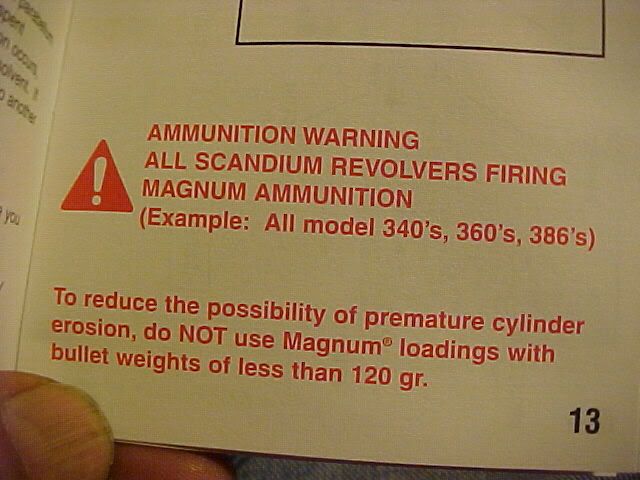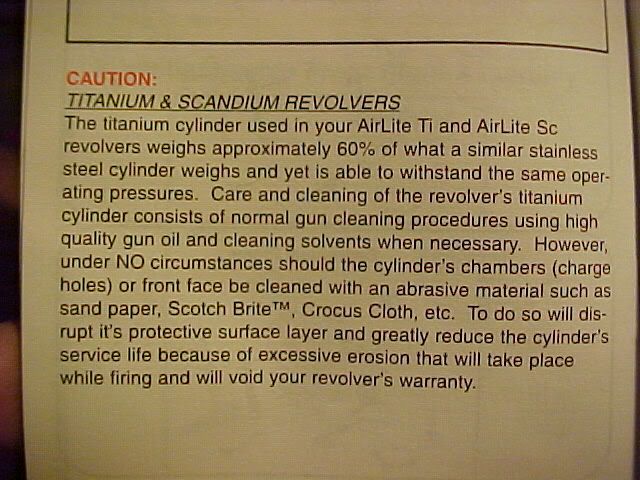Yep, the selection of ammunition used in the really lightweight Ti, Sc & PD revolvers is important.
The current S&W revolver Owner Safety & Instruction Manual breaks it down as follows:
AMMUNITION SELECTION FOR Ti, Sc& PD Series REVOLVERS
Before placing any of these reduced weight revolvers into service, perform the following test to determine the suitability of the ammunition you intend to use.
At a gun range or other suitable and safe location, prepare your revolver for firing by fully loading its cylinder with the ammunition to be tested. While pointing the firearm in a safe direction, fire all but the last round. Remove the empty casings and the last
loaded round from the revolverʼs cylinder.
Carefully inspect the loaded round to determine if its bullet has started to unseat (move forward) from its casing.(Figure 2) If it has, you should not use the tested ammunition in your revolver. Choose another projectile weight or brand of
ammunition and repeat this test until you find one that DOES NOT UNSEAT under these test conditions. When you are finished, fully unload your revolver and secure it safely.
As well as:
CAUTION:
Do not use Magnum loadings with bullet weights of less than 120 grains - This will reduce the possibility of premature erosion in titanium alloy cylinders.
This last precaution has always been explained to me to be based on the consideration that the powders used in the Magnum loads using really light bullet weights produce hotter gases which can cause premature gas erosion of the titanium cylinder charge holes and cylinder face.
I remember when I was talking to one of the folks at the factory and he told me they has just received one of their lightweight Magnum J-frames back for warranty because the owner said he was experiencing bullet pull when using 158gr JHP jacketed ammunition. The factory tried using the same ammunition and couldn't get the bullets to unseat and pull from then case mouths ... until they thought to try holding the gun in a fairly loose grip. Then they started to see some bullets come unseated. Not with a heavy grip, but with a light grip.
Now, remember that heavier bullets cause more felt recoil directed back into the shooter's hand, and it starts to make sense that unless the gun is held tightly and supported against recoil forces, that momentum might start to come into play and the revolver & case will start to move backwards away from the unfired rounds fast enough to allow the bullet's tendency to remain in the same position may overcome the crimp ... and especially if the crimp is less than optimal.
The gentleman from the factory said that they had never anticipated anyone would try to shoot those ultra lightweight J-frames with anything short of a really strong grip. Well, with that in mind, I suppose now we might consider the possibility of being able to 'limpwrist' an ultra lightweight Magnum and maybe see some ammo problems.
Now, my M&P 340 has a steel cylinder (instead of titanium). It's use of an alloy barrel shroud & yoke gave it a bit less weight than my 642. Add in the Bantam grip, which weight an ounce less than the regular rubber boot grips I have on my 642's, and the gun tipped my digital scale at about 13.3 oz, which duplicates the factory specs. That puts its weight somewhere in the middle between the Airlite Magnums with their Ti cylinders and my 642's.
When I first took it to the range I took along something like 4-5 brands of Magnum ammo and a couple of +P loads, so I could check for bullet pull in
my gun when being fired in
my hands. I found a couple of the Magnum loads that exhibited a noticeable degree of bullet pull. Enough said. I won't use those brands/loads. Not until I retest someday with with new boxes of those loads.
Then, since I didn't care for the small & soft Bantam grips, I replaced them with some older rubber Boot grips and brought the weight of the gun up to 14.3 oz. It was still lighter in my pocket than my 642's and I liked the grip better.
Here's a link to the current Revolver Manual from the S&W website:
http://www.smith-wesson.com/wcsstore/SmWesson2/upload/other/S&W_Revolver_Manual.pdf
I've only fired 2-3 hundred rounds of Magnum loads through my M&P 340. It's not pleasant and quickly starts to hurt, although that could be because I've fired the Magnum loads for regular training & qualification drills that include rapid fire double taps and multiple shot strings under a time requirement.
I much prefer +P loads and that's what I commonly carry, anyway. I can get excellent accuracy and can fire them at speed with good controllability. That's why I bought the gun and carry it, and my other J-frames, after all.
I'm not a particular enthusiast of the internal locking system (ILS), but after taking the armorer's class for the little gun and talking with a number of armors for other agencies, and not hearing of any problems occurring when their folks have been shooting the range of J-frames in use, which includes the ultra light weight models ... and after having handled and fired, and have observed a fair number of other owners firing ILS equipped J-frames ... the lock no longer keeps me awake at night.

I notice there's been at least one revision of the torque lock spring used to keep the locking arm down under recoil when I've ordered spare parts.
FWIW, the bottom dog leg of the torque lock spring must be properly seated within the frame recess in order to keep the lever pulled down. I noticed in the class that removing the hammer and the bolt (which slips in the frame's bolt slot in which the spring's leg is positioned in the recess), and tipping the frame to the right, can allow the spring's leg to come unseated. This will result in the locking arm not being held down under recoil as intended. This is a good reason why folks not familiar with the new model design probably ought not to take their guns apart to tinker with them.
I was also told one time when talking to someone from S&W that it's important during production & assembly that this spring be properly located & seated in order for the ILS to function as designed.
Now, although I carry my M&P 340 without being overly concerned about the ILS just as often as I carry one of my 642-1's, since I'm not exactly an enthusiast of the ILS for
my needs ... (I take other steps to prevent unauthorized access to my guns) ... I'd be prone to buy one of the M40/42's or one of the limited models which are now being offered without the ILS. I wish one of them was made without requiring moon clips, though, but that's another subject for another day.

As usual, just my thoughts ...





